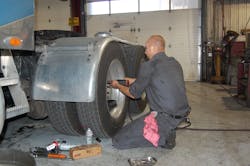When you start talking brakes and trucking safety, there’s good news to be had. For starters, mandates put in place several years ago (see sidebar) significantly beefed up the stopping power of both S-cam drum brakes – still the most widely-used braking system in trucking – and air disc brakes (ADBs), which are lately experiencing an uptick in demand here in the U.S.
Yet when it comes to how they operate and the specific maintenance each requires, drums and ADBs remain very different. And keeping those differences in mind, especially in situations when both braking systems are used on the same tractor-trailer, is critical to ensuring both deliver maximum performance.
“Truckers are still investing in drum brakes, simply because the gap between ADB and drum brake performance is not nearly as wide as it used to be,” explains Jim Reis, vice president of Stemco Brake Products.
“Drum brakes are now providing stopping distances that are very close to ADBs, even considering new reduced stopping distance requirements. So from a safety and performance standpoint, drum brakes are performing at an acceptable range while being a lot cheaper to purchase and maintain.”
Reis points out, however, that ADBs offer longer life before replacement so trucks that stop more often, especially when fully loaded, may see benefits.
“That’s why brake manufacturers understand that there may be vocation-specific circumstances where air disc brakes are a better fit,” he notes. “That being said, the performance and technology of drum brakes are being improved continuously. High-performance drum brake packages that meet the needs of high duty-cycle customers are on the horizon.”
John Thompson, sales manager CV-NAFTA at TMD Friction, notes that the current adoption rate for ADBs in the U.S. trucking industry is approximately 15%, with more mixed use of ADBs and drum brakes occurring.
“There are truck builders who are standard ADB on just the steer axles, while there are fleets with ADBs across the board on all axles of the tractor and trailer. But there are also fleets with tractor only and trailer only ADBs as well,” he says. “That’s why careful attention must be paid to potential compatibility issues between drums and ADBs.”
In general line-haul usage, Thompson says compatibility is usually not an issue.
“It’s in the more extreme applications, such as heavy haul or mountainous regions, where the differences in brake designs can be accentuated,” he explains.
Thompson points out that transit and refuse fleets are moving more and more to ADBs to gain more consistent stopping power, performance at higher temperatures, longer life and faster relines.
“However, long haul and even some regional fleets are converting to ADBs for longer [brake] life,” he emphasizes.
One area often overlooked in the discussion of which type of brake system to spec is what kind of friction material to use, Thompson says.
“Some suppliers sell a one-size-fits-all friction material, such as a one-disc pad option that’s high friction, so as to meet the highest axle load,” he explains. “Lower axle loads are compensated for by changing to a smaller air chamber.”
He stresses that tribology – the science and engineering of interacting surfaces in relative motion, which includes the study and application of the principles of friction, lubrication and wear – dictates that the higher the friction, the higher the wear, regardless of air chamber size.
“That’s why tailoring the friction levels of [brake] pads for specific trucking applications can significantly increase pad and rotor life, which reduces maintenance lifecycle costs on commercial vehicles,” he notes.
When it comes to the maintenance particulars of ADBs, there are some advantages when compared to traditional drum brakes, notes Jon Morrison, president of the Americas for Wabco Holdings:
- ADBs allow for extended service intervals; up to two times longer than drum brakes. ADBs also require about half the time to perform a normal brake service. This is more important for trailers as the trade cycle can be more than double that of a truck/tractor. This will change, however, as the cost of ADBs is reduced and the value proposition achieves a payback in the two-year time frame.
- Air disc brakes are helpful in reducing the fleet and driver impact of CSA out-of-service violations. Since ADBs do not need to be adjusted, this eliminates the opportunity for a “brakes-out-of-adjustment” violation. This can be important for driver retention as well when the driver does not have to worry about this impacting their score.
- The consistency of ADBs combined with the fact that adjustments are not needed are leading many truck owners who use electronic stability control and collision mitigation technology to adopt ADBs for their stable braking performance.
- In regards to trailer applications, ADB provides up to 100 lbs. in weight savings per trailer over drum applications.
Still, ADBs come with a significant price premium attached, driven largely by the truck OEMs: sometimes between $2,500 and $5,500, notes Nicole Oreskovic, product director for air disc brakes at Bendix Commercial Vehicle Systems.
Wabco’s Morrison notes that to increase ADB adoption two or three fold, he thinks ADBs will need to be within a $600 to $800 “delta” in terms of additional cost.
And he cautions that simply building more ADBs won’t necessarily make them cheaper.
“It’s not scale: volume does not automatically convey lower cost,” Morrison stresses. “It’s about less weight and better integration for ADBs at the wheel end. It’s about optimizing the wheel end with ADB-friendly brackets and hub/rotor interfaces. And OEMs have to commit to that fundamental optimization.”
When it comes to maintenance for ADBs and drums, brake pad lining thickness is an issue both share in common.
“With colder months approaching, it’s crucial to make sure that the lining thickness will get you through the winter,” notes Stemco’s Reis. “While every season is different, winter problems can be a lot more acute. We commonly see rust or cracking of the lining during colder times of the year.”
He adds that truck operators with drum brakes should also check that they are protecting the function of the automatic brake adjuster by ensuring that they are within stroke limits, are properly lubricated and bushings are within wear tolerance.
Kevin Pfost, technical service coordinator with Bendix Spicer Foundation Brake, points out several other key facets of drum brake maintenance truck owners using ADBs typically don’t need to worry about:
- Measuring stroke: To measure brake stroke, bleed the air system down to between 90 and 100 psi [pounds per square inch) and note the center of the clevis pin’s position. Next, either have someone fully apply the brakes and hold the pedal down, or wedge the brake pedal in the fully applied position. This will actuate the brakes between 90 and 100 psi. Note the new position of the center of the clevis pin. The distance between the two marks indicates the brake’s power stroke. The maximum allowable power stroke or “free play” varies depending on the chamber size and type. Typically though free play should be between 3/8 in. and 5/8 in. and should be the same across all the brakes, truck and trailer alike.
- Same size: There are two common types of brake chambers – standard and long stroke – as well as two common sizes of slack adjusters (5.5 in. and 6 in., as measured from the center of the cam shaft to the center of the clevis pin). For both regulatory and brake performance reasons, all slack adjusters and air chambers on any given axle must be the same type and size.
- No manual adjusting: “If the brake is out of adjustment, do not adjust the automatic slack adjuster (ASA) – I can’t emphasize this enough,” Pfost says. “There are many factors that can cause an automatic slack adjuster to overstroke, but none will be remedied by a manual readjustment. Manually adjusting an ASA involves working against its internal back-off clutch, which can impact the life of the adjuster.”
- Grease to capacity: When greasing drum brakes, it’s important to grease the brake to capacity, Pfost stresses. “Putting in less grease than is needed to fill all interior gaps can lead to condensation forming inside the brake components, which may cause rust and corrosion,” he explains. “Seals inside the cam tube are engineered to let excess grease out of the area, meaning new grease should be added until any dirty grease or condensation is visibly purged out of the end cam-tube near the slack adjuster.”
- Check cam bushing radial play: If the radial play on a cam bushing is 0.03 of an inch or more, the cam bushing or camshaft is worn and needs to be replaced for too much radial play leads to uneven brake shoe wear, as well as a loss of stopping power. Pfost recommends keeping radial play below 0.01 of an inch by replacing cam bushings as needed. “Cam bushings are a low-cost component that can make a huge difference in the long run,” he notes, with bronze bushings recommended for severe-duty vehicles and heavy-wear brake situations, such as refuse vehicles. Nylon bushings generally suffice for line haul and highway applications.
- Replace worn shims: Shims (the nickname for washers) help prevent road grime and other contaminants from getting into the drum brake system. “But shims get worn down through exposure to the elements and road grit, so we recommend changing the shim packs during brake jobs,” Pfost stresses. “The few minutes spent making these measurements, re-shimming, and re-bushing are well worth the extension in brake life and performance.”




